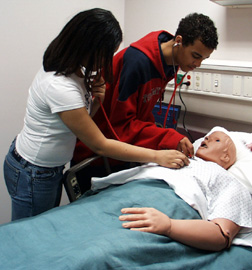The blue-eyed male patient blinks as UNMC College of Nursing students walk into the room. From his hospital bed, the 75-pound patient talks with students as they listen to his heart, check his pulse and watch his chest rise and fall.
In an instant, the patient’s condition deteriorates and the students scramble to respond. If successful, the patient will stabilize. If not, he may die.
 |
During a recent visit to campus, Youth Leadership Omaha participants listen to the patient simulator’s heartbeat. |
Such scenarios are being played out in the UNMC College of Nursing, which has two life-sized mannequins — the only two in the state — designed to simulate patient conditions. Similar to real life, the patient blinks, responds to medication and can be given an IV or tracheotomy. He can even be programmed to talk.
High-tech, low-risk tool
The college recently began using the high-tech, low-risk education tool, developed by Medical Education Technologies Inc. (METI), to better train undergraduate and graduate nurses. The College of Nursing Lincoln division acquired UNMC’s first mannequin, followed by the Omaha campus. The goal is for the Kearney and Scottsbluff divisions to each have a mannequin by fall.
“The human patient simulator helps students get over their anxieties before they go into clinical situations,” said Louise LaFramboise, Ph.D., assistant professor in the College of Nursing-Omaha. “This is a grand opportunity to make students a lot more solid in their understanding of patient experiences.”
Expanding clinical experiences
METI’s relatively new Emergency Care Simulator (ECS) is a scaled-down version of its original, more expensive model. Overall, human patient simulators have existed approximately six years.
The ECS simulator expands the clinical experiences students encounter, said Patti Carstens, director of the College of Nursing’s Learning Resource Center. “The more simulation we can give students the more we can take away the stress and anxiety of treating real patients,” she said.
The patient simulator, which can be programmed to respond as a 30 or even 90-year-old, gives students consistent assessment experiences in a low-risk environment. It also guarantees them exposure to certain clinical situations and develops critical thinking skills, Dr. LaFramboise said. In addition, the mobile simulator enables faculty members to do competency testing, as well as create real-life situations outside the comfort of a well-lit hospital room.
Mimicking real-life situations
Using the simulator, students can measure the patient’s carbon dioxide levels, perform CPR, learn to intubate, watch his tongue swell, and find a pulse on his soft, rubbery “skin.” A compressor pumps air into his lungs and a saline solution, which runs through his body, can be “colored” to resemble urine or secretions from the mouth, nose or eyes.
METI, based in Sarasota, Fla., has additional simulator packages available related to bioterrorism and mass trauma. In addition to the adult patient, they also market a pediatrics patient.
UNMC nursing faculty members say this “patient” won’t play a silent role in his treatment. “We can program him to say “Ouch! What are you doing?” so students don’t forget there’s a person here and not just an arm that needs an IV,” Dr. LaFramboise said.